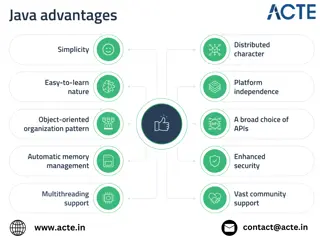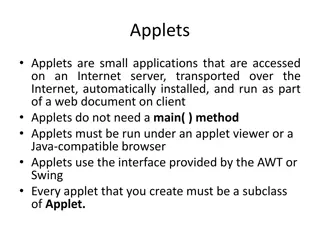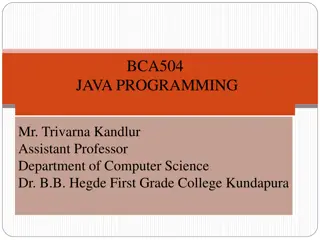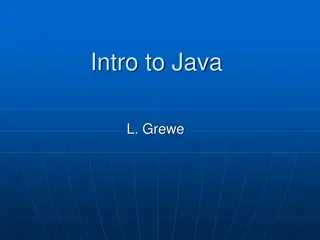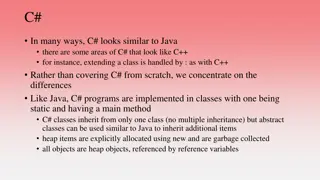Java Application Development Basics
Learn how to create a Java application with a main method using Eclipse. Understand the concept of method parameters and how to provide arguments when running the application through Eclipse's Run Configurations feature. Explore the structure of packages in Java and the Java API.
Download Presentation

Please find below an Image/Link to download the presentation.
The content on the website is provided AS IS for your information and personal use only. It may not be sold, licensed, or shared on other websites without obtaining consent from the author. Download presentation by click this link. If you encounter any issues during the download, it is possible that the publisher has removed the file from their server.
E N D
Presentation Transcript
CS2110, Recitation 2 Arguments to method main Packages APIspecs Characters Strings
Demo: Create application To create a new project that has a method called main with a body that contains the statement System.out.println( Hello World ); do this: Eclipse: File -> New -> Project File -> New -> Class Check the method main box In the class that is created, write the above blue statement in the body of main Hit the green play button or do menu item Run -> Run
Java Application public static void main(String[] args) { } Parameter: String array A Java program that has a class with a static procedure main, as declared above, is called an application. The program, i.e. the application, is run by calling method main. Eclipse has an easy way to do this.
Method main and its parameter public static void main(String[] args) { } Parameter: String array In Eclipse, when you do menu item Run -> Run (or click the green Play button) Eclipse executes the call main(array with 0 arguments); To tell Eclipse what array of Strings to give as the argument, start by using menu item Run -> Run Configurations (see next slide)
Window Run Configurations This Arguments pane gives argument array of size 3: args[0]: SpeciesData/a0.dat args[1]: 2 args[2]: what for? Click Arguments pane Quotes needed because of space char Quotes OK, but not needed
DEMO: Giving an argument to the call on main Change the program to print the String that is in args[0], i.e. change the statement in the body to System.out.println(args[0]); Then Do Run -> Run Configurations Click the Arguments tab In the Program field, type in Haloooo there! Click the run button in the lower right to execute the call on main with an array of size 1
PACKAGES AND THE JAVA API Package: Collection of Java classes and other packages. See JavaSummary.pptx, slide 20 Available in the course website in the following location: http://www.cs.cornell.edu/courses/CS2110/2016sp/links.html Three kinds of packages (1) The default package: in project directory /src (2) Java classes that are contained in a specific directory on your hard drive (it may also contain sub-packages) (3) Packages of Java classes that come with Java, e.g. packages java.lang, javax.swing.
PACKAGES Directory for default package Java file in package Directory for package named CS2110Stacks Java files in package
Importing the package Every class in package pack1 (in directory pack1 ) must start with the package statement Every class outside the package should import its classes in order to use them import pack1.*; package pack1; public class Rec02 { publicclass C { } }
Importing API packages You can do this: publicclass C { javax.swing.JFrame jf= new javax.swing.JFrame(); } Or this: import javax.swing.JFrame; To import all classes in package javax.swing, use publicclass C { JFrame jf= new JFrame(); } import javax.swing.*;
Finding package documentation Scroll through here
Package java.lang vs. other packages You can use any class in package java.lang. Just use the class name, e.g. Character To use classes in other API packages, you have to give the whole name, e.g. javax.swing.JFrame So you have to write: javax.swing.JFrame jf= new javax.swing.JFrame();
Use the import statement! To be able to use just JFrame, put an import statement before the class definition: Imports only class JFrame. Use the asterisk, as in line below, to import all classes in package: import javax.swing.JFrame; public class C { public void m( ) { JFrame jf= new JFrame(); } } import javax.swing.*;
Other packages on your hard drive One can put a bunch of logically related classes into a package, which means they will all be in the same directory on hard drive. Reasons for doing this? We discuss much later. Image of Eclipse Package Explorer: project has default package and 3 projects: Default package has 2 classes: Rec02, Rec02Tester package pack1 pack1 has 1 class: C
Hard drive Eclipse Package Explorer Eclipse Hashing I03Demo recitation02 src Rec02.java Rec02Tester.java pack1 C.java Eclipse does not make a directory for the default package; its classes go right in directory src
Primitive type char Use single quotes Unicode: 2-byte representation Visit www.unicode.org/charts/ to see all unicode chars char fred= 'a'; char wilma= 'b'; System.out.println(fred); a
Special chars worth knowing about ' ' - space '\t' - tab character '\n' - newline character '\'' - single quote character '\"' - double quote character '\\' - backslash character '\b' - backspace character - NEVER USE THIS '\f' - formfeed character - NEVER USE THIS '\r' - carriage return - NEVER USE THIS Backslash, called the escape character
Casting char values Cast a char to an int using unary prefix operator (int), Gives unicode representation of char, as an int (int) 'a' gives 97 (char) 97 gives 'a' (char) 2384 gives ' ' Om, or Aum, the sound of the universe (Hinduism) No operations on chars (values of type char)! BUT, if used in a relation or in arithmetic, a char is automatically cast to type int. Relations < > <= >= == != == 'a' < 'b' same as 97 < 98, i.e. false 'a' + 1 gives 98
Class Character An object of class Character wraps a single char (has a field that contains a single char) Character c1= new Character('b'); Character c2= new Character('c'); Don t know field name Character@a1 Character@b9 c1 c2 Character@a1 ??? 'b' charValue() compareTo(Character) equals(Object) Character@b9 ??? 'c' charValue() compareTo(Character) equals(Object)
== versus equals true iff c1, c2 contain same values false false true c1 == c2 c3 == c1 c1 == c1 c1.equals(c2) c3.equals(c1) true iff c2 is also a Character object and contains same char as c1 true Error!!! Character@a1 Character@b9 null c1 c2 c3 Character@a1 ??? 'b' charValue() compareTo(Character) equals(Object) Character@b9 ??? 'b' charValue() compareTo(Character) equals(Object)
Class String String: special place in Java: no need for a new-expression. String literal creates object. String s= CS2110 ; s String@x2 String@x2 ??? CS2110 Find out about methods of class String: docs.oracle.com/javase/8/docs/api/ index.html?java/lang/String.html length() charAt(int) subString(int) subString(int, int) equals(Object) trim() contains(String) indexOf(String) startsWith(String) endsWith(String) more Lots of methods. We explain basic ones Important: String object is immutable: can t change its value. All operations/functions create new String objects
Operator + + is overloaded "abc" + "12$" evaluates to "abc12$" If one operand of concatenation is a String and the other isn t, the other is converted to a String. Sequence of + done left to right 1 + 2 + "ab$" evaluates to "3ab$" Watch out! "ab$" + 1 + 2 evaluates to "ab$12"
Operator + System.out.println("c is: " + c + ", d is: " + d + ", e is: " + e); Using several lines increases readability Can use + to advantage in println statement. Good debugging tool. Note how each output number is annotated to know what it is. Output: c is: 32, d is: -3, e is: 201 c e 201 d -3 32
Picking out pieces of a String s.length(): number of chars in s 5 Numbering chars: first one in position 0 01234 "CS 13" s.charAt(i): char at position i String@x2 s.substring(i): new String containing chars at positions from i to end s.substring(2) is ' 13' ? "CS 13" length() charAt(int) subString(int) subString(int, int) more s.substring(i,j): new String containing chars at positions i..(j-1) s.substring(2,4) is ' 13' Be careful: Char at j not included! s String@x2




